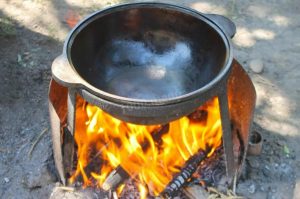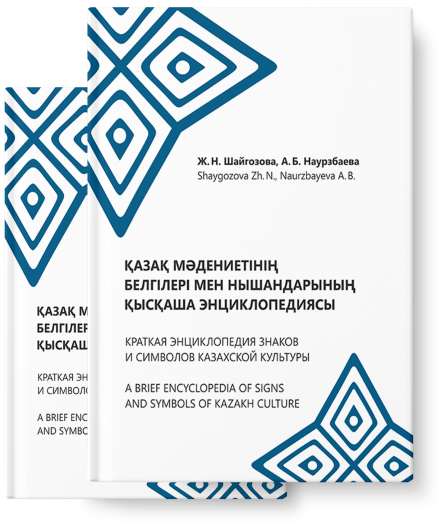
A short encyclopedia of
Signs and symbols of
Kazakh culture

Oshaq (hearth) is a semantic center of the living space, a symbol of the family’s well-being. Here food is prepared and sacrifices are offered to the sacred fire – the host of the hearth (the rite “otqa mai kuyu”, which is part of the wedding cycle of the Kazakhs). The bride, entering the groom’s house for the first time, pours melted fat into the fire of the hearth, and the women present utter a phrase: “Ot-ana, Mai-ana, zharilqa” – “Mother-fire, Mother-Umay, bless me”. The worship of the hearth goes back to the idolization of fire, traces of which can be found in many other elements of Kazakh culture (e.g., not stepping on ashes).
The association of the hearth with life is also emphasized by the fact that when mourning the deceased, the women stood with their backs to the hearth and faced the yurt’s bars, thus protecting the sacred center from death, the energy of the afterlife. The most terrible curses are contained in the words, “Oshaqta otyn sönsin” (“Let the fire in your hearth go out”).
The cauldron is semantically linked to the hearth, which is an important symbol in Turkic culture. The sacralization of the cauldron is a worldwide phenomenon. It is associated with notions of abundance (the vessel of life), is considered an inexhaustible source of life, renewal, rebirth, and embodies a transformative power.
The mytho-ritual status of the cauldron can be traced back to the Saka culture; it was considered a divine attribute. The analysis of numerous archaeological materials has shown that the metal cauldron is a “symbol of the representatives of a high social rank”, “sign of the breadwinner and the head of the family, the tribe”, “symbol of power” [2, p.115]. Thus, the Turkestan “taiqazan”, which, according to popular belief, consists of an alloy of seven precious metals, is revered to this day as a sacred symbol of prosperity.
In daily life, Kazakhs are forbidden to turn the qazan (upside down). Such an action was considered negative and meant the end of life, death (the source of life dried up). Kazan as a sacred attribute – a symbol of wealth, so it should never be empty. On the bottom always remained at least one spoonful of oil, which, according to the wishes of the house, symbolized satiety in the family: “Qazan – oshağynan qūt ketpesin!” (May the food in this house never end, the happiness of your house never fade away) [6, p.25]. Qazan was passed by inheritance exclusively through the male line, and if it happened to borrow, they should not have returned empty or tied to the ear white cloth (Aqtyq bailau). Probably, this act emphasizes the most important sacral and functional “duty” of the Qazan – not to stop giving food, to feed (to feed, to eat)

